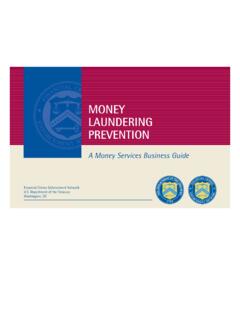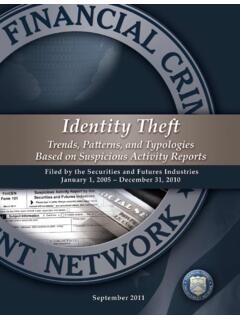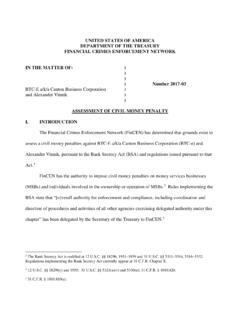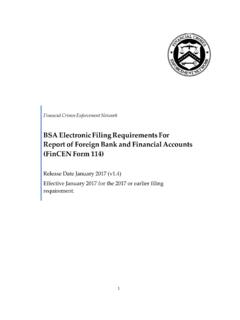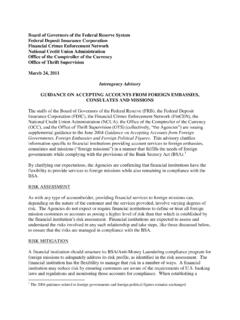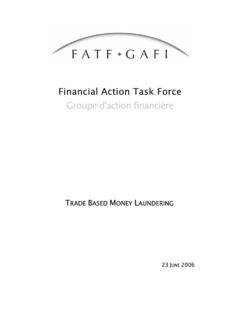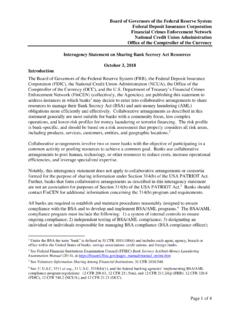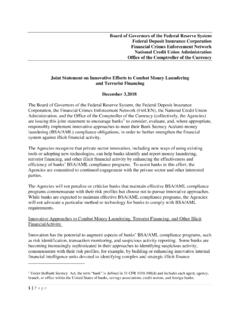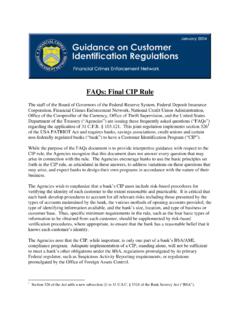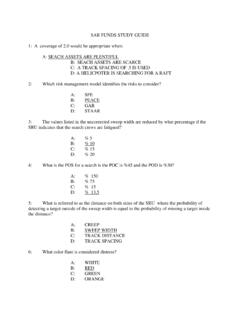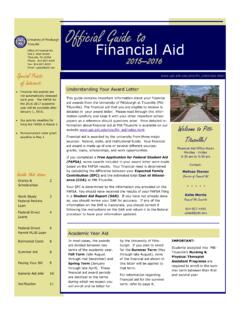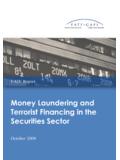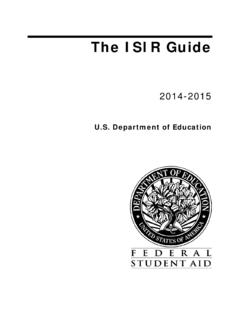Transcription of Financial Crimes Enforcement Network
1 Financial Crimes Enforcement NetworkInsurance IndustryFinancial Crimes Enforcement Network Insurance IndustryFinancial Crimes Enforcement NetworkInsurance IndustryAn Assessment of Suspicious Activity Report Filings April 2008 Suspicious Activity Reporting Insurance IndustryFinancial Crimes Enforcement Network Insurance IndustryFinancial Crimes Enforcement NetworkPurpose 1 Executive Summary 3 Background 5 Methodology 7 Research and Analysis 9 Significant Findings 21 Conclusions & Recommendations 35 Appendix A 37 Appendix B 39 Table of Contents vInsurance IndustryFinancial Crimes Enforcement Network Insurance IndustryFinancial Crimes Enforcement NetworkPurposeThis report highlights key findings of an assessment conducted by the Finan-cial Crimes Enforcement Network (FinCEN) of Suspicious Activity Report (SAR) filings in the one-year period from May 2, 2006 through May 1, 2007 by insurance companies regarding suspected money laundering and other finan-cial Crimes .
2 FinCEN conducted this assessment for filings by this industry, which is relatively new to anti-money laundering (AML) compliance, to identify typolo-gies, trends and patterns relating to filing volume, filer location, subject location and occupation, characterizations of suspected Crimes , and other factors relevant to the reporting of suspicious activity on a variety of insurance products. This report includes summaries of actual SAR narratives, revealing potential money laundering trends and frequently reported money laundering schemes. This report also in-cludes preliminary observations regarding SARs filed from May 2007 through Oc-tober 2007.
3 Consistent with FinCEN s mission to provide beneficial information to law Enforcement , regulators and regulated industries, this report will present indicia of possible illicit activity that some insurance companies have identified, and hence raise awareness of possible risks and vulnerabilities. This report offers insight into the quality of the reporting. SAR narratives should make available clear, concise and invaluable information to law Enforcement investi-gators. The relatively new reporting requirements on certain segments of the insur-ance industry provide an opportunity for an early evaluation of the quantity, quality and substance of existing filings.
4 This opportunity for feedback to the industry can promote better information for law Enforcement and will help establish a foundation to shape FinCEN s future analysis and guidance efforts. Insurance IndustryFinancial Crimes Enforcement Network Insurance IndustryFinancial Crimes Enforcement NetworkExecutive SummaryFinCEN is committed to providing quality written feedback to industries af-fected by new or changed regulations. The optional requirement for certain insurance companies to file SARs regarding some covered products became mandatory in May 2006. FinCEN previously issued brief reports concerning SARs filed by the insurance industry in February 2003 and again in May 2007.
5 This report provides a more in-depth review of insurance company SAR filings and will serve to provide a baseline for future comparisons. Overall, the quality of SAR reporting has been quite good, indicating that insur-ance companies are well positioned to report to law Enforcement several specific categories of suspected illicit activities relating to money laundering. In addition, they are equally poised to provide through SARs, information that may benefit the mission of state regulatory analysts read and reviewed each of the 641 SARs filed by insurance com-panies between May 2, 2006 and May 1, 2007.
6 The majority of SARs filed by unique corporate entities were produced in Massachusetts, New York, and Ohio. The resi-dences of the majority of the individuals who were the subjects of these SARs were located in New York, California, Florida, and New categorized over half of the subjects as policyholders of either the insured, the beneficiary, the payer, or the applicant. The next largest category of subjects was the applicant or owner of an annuity. Consistent with data from all other Financial services industries, insurance compa-ny filers most commonly cited BSA/Money Laundering/Structuring as the charac-terization of suspicious activity.
7 Structuring, where larger transactions are broken into smaller exchanges, is consistent with an attempt to avoid currency reporting requirements. Insurance IndustryFinancial Crimes Enforcement NetworkThe data revealed some potential trends in illicit activity. Some of the typologies evidenced in the narratives appeared very similar to classical examples of the money laundering stages of layering and For example, subjects sometimes used multiple cash equivalents ( , cashier s checks and money orders) from differ-ent banks and money services businesses to make policy or annuity payments, and then cashed out the insurance products to potentially disguise the original source of the funds.
8 Also, some customers seemed unusually willing to incur significant penalties for surrendering their annuities before full term. FinCEN agrees that both the insurance regulators and industry will benefit from a more industry-specific format for reporting suspicious activity. Currently, insurance industry SARs are being filed on the SAR-SF, which was designed for the Securities and Futures industry. The Suspicious Activity Report by Insurance Companies No-tice and Request for Comment was published in the Federal Register on November 3, FinCEN has instructed insurance filers to add SAR-IC after the name of the in-stitution (Part IV, Field 36) and begin the narrative with the term, Insurance SAR (Part VI).
9 3 This study found that some filers did not follow these instructions, thus hindering the identification of those filings as insurance SARs. Additionally, some filers include disclaimers in narratives. Disclaimers add no value to the SAR narra-tive and should be omitted. Money laundering is a well-thought out process accomplished in three stages: Placement: Requires physically moving and placing the funds into Financial institutions or the retail economy. Depositing structured amounts of cash into the banking sector, and smuggling currency across international borders for further deposit, are common methods for placement.
10 Layering: Once the illicit funds have entered the Financial system, multiple and sometimes complex Financial transactions are conducted to further conceal their illegal nature, and to make it difficult to identify the source of the funds or eliminate an audit trail. Purchasing monetary instruments (traveler s checks, banks drafts, money orders, letters of credit, securities, bonds, etc.) with other monetary instruments, transferring funds between accounts, and using wire transfers facilitate layering. Integration: The illicit funds re-enter the economy disguised as legitimate business earnings (securities, businesses, real estate).
